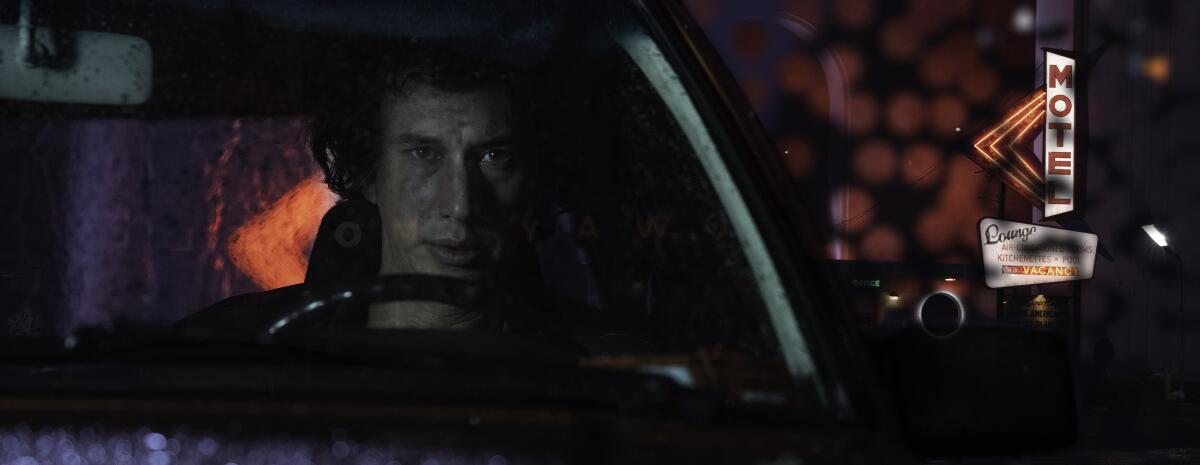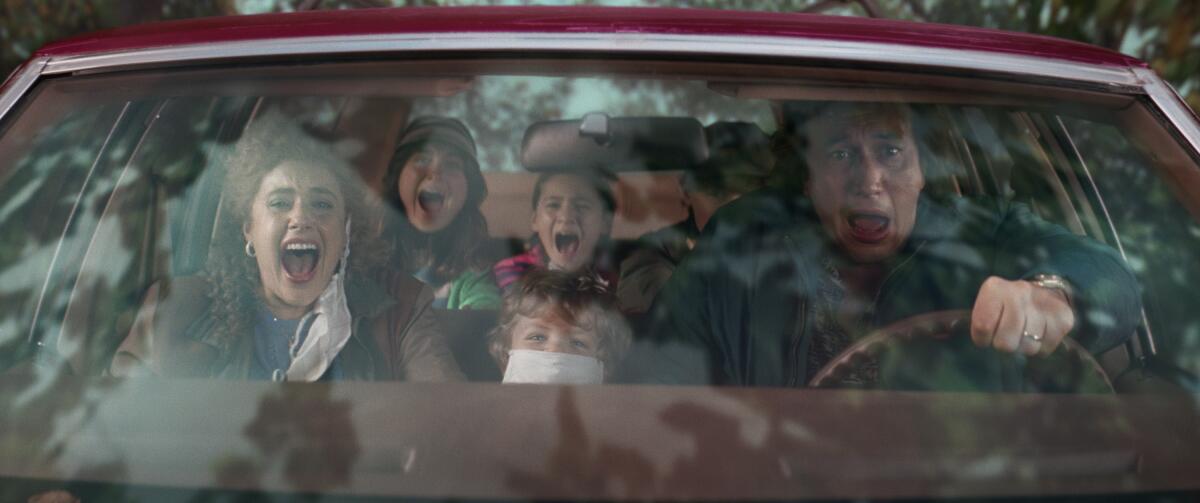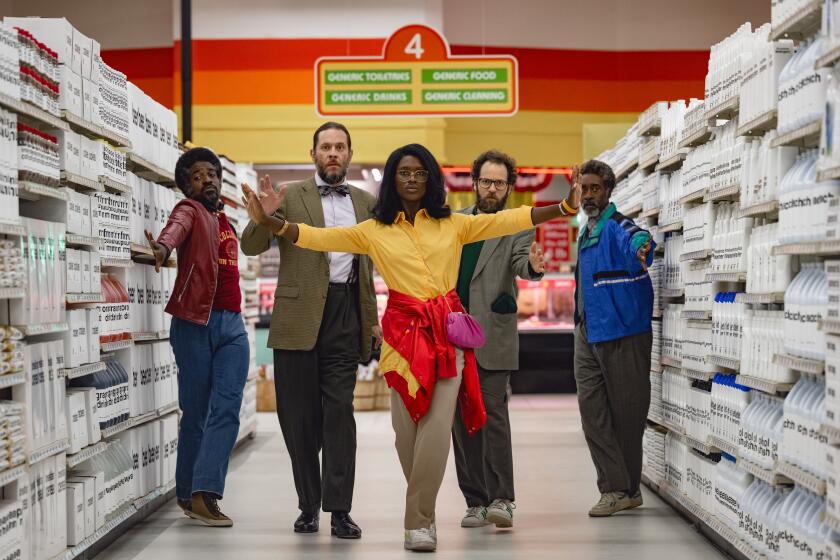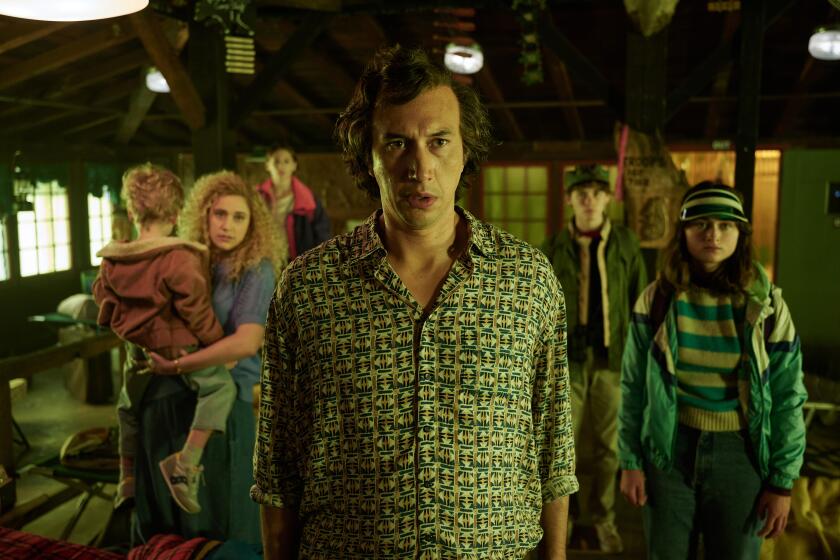Page to Screen: An exuberant âWhite Noiseâ reinvents Don DeLillo â and Noah Baumbach

Late in Don DeLilloâs classic novel âWhite Noise,â a scholarly friend discussing cinematic car crashes tells the storyâs protagonist, âLook past the violence, Jack. There is a wonderful brimming spirit of innocence and fun.â In the book, itâs one of many absurd platitudes the characters use to make sense of a nonsensical world. In Noah Baumbachâs adaptation, itâs part of the opening scene: The scholar (Murray Siskind, played by Don Cheadle) screens a reel of stunt crashes for his students, and his comments set the tone for the film.
The violence of the novel is there â man-made disaster, attempted murder, Nazism â but for perhaps the first time in a Baumbach film, so is a pervasive spirit of innocence and fun, along with an eye-popping visual flair heâs kept concealed for far too long. Whereas the book built up a kind of fatalistic resignation, Baumbachâs version of âWhite Noiseâ is genuinely exuberant. Case in point: In a closing supermarket scene, DeLillo described shoppers as âaimless and haunted.â In the film, the same moment ends in an eight-minute dance number incorporating the expansive cast.
Yet framing this as a dichotomy glosses over the complexity of the source material. At the heart of the novel was always a bubbling domestic comedy, and not of the bitter, dysfunctional kind weâve seen in previous Baumbach films. Jack Gladney (Adam Driver) and his wife, Babette (Greta Gerwig), truly care for each other; the marriage glows with tenderness. Baumbach runs with their childrenâs antic energy and lets it suffuse other parts of his film, animating even the storyâs more difficult third part with humor and affection that reflect the bookâs tone. Rather than betraying the novelâs savage critique of modern life, Baumbachâs approach illuminates DeLilloâs humanism in the directorâs least cynical film since âKicking and Screamingâ â and easily the most daring heâs made.
Why does Netflixâs adaptation of the Don DeLillo classic end with a dance sequence in a supermarket? Director Noah Baumbach breaks it down.
Like the novel, âWhite Noiseâ the film contains three distinct parts. âWaves and Radiationâ introduces us to the Gladney family and Jackâs academic work in his first-of-its-kind Hitler studies department. âThe Airborne Toxic Eventâ tracks an industrial chemical leakage that throws the familyâs life into crisis. âDylarama,â taking up the second half of both book and film, documents Babetteâs clandestine participation in an unsanctioned medical trial.
Remarkably, the intellectual satire, environmental disaster tale and noir coalesce more smoothly in Baumbachâs movie than they did in the novel. A shadowy rogue pharmaceutical figure who dominates the storyâs third part now drifts like an apparition through its first and second, rather than disorienting with a late entrance. More significantly, Baumbach makes a bold and divergent choice to bring Babette into the climactic confrontation and its fallout. Her presence adds a valuable grace note, contributing to the filmâs surprising optimism.
It was Brian De Palma, not a purveyor of innocent fun, who suggested Baumbach consider an adaptation to try things Baumbachâs own scripts wouldnât allow. The latter filmmaker co-directed a documentary about De Palma in 2016, and at the time, they seemed an unlikely duo: the elder an auteur of the lurid and gruesome (originals such as âBlow Out,â adaptations including âCarrieâ), the younger firmly planted in the confines of grown-up mumblecore (âGreenberg,â âFrances Haâ).

Watching âWhite Noise,â though, the pairing begins to make sense. Who knew Baumbach had it in him to choreograph intricate crowd scenes, crane-shoot crashing and combusting trains or stage a payback shooting at a sleazy motel bathed in neon-lit De Palma shades? Certainly no one familiar with Baumbachâs filmography, in which the most striking image to date was of two silent people in an empty subway car.
Adam Driver and Greta Gerwig star in Noah Baumbachâs restlessly inventive movie about consumerism, addiction, environmental ruin and other creeping anxieties of modern life.
Despite its long-assumed unadaptability, DeLilloâs story contains a number of memorable visual moments, and Baumbach takes advantage. A first-act set piece takes place in a classroom so impossibly twee it seems like a tribute to past collaborator Wes Anderson. But what starts off as a composition of colorblock and Fair Isle takes on sudden urgency in Baumbachâs hands. He splices in not only relevant found footage but also the toxic eventâs precipitating accident, about which the book barely speculates. In the process he draws a line from mass hysteria to human carelessness, the results of which can be similarly catastrophic. And isnât that the theme of these last few years?
The emergency response to the Airborne Toxic Event is the centerpiece of both book and film, and Baumbach brings it to life with flourishes of his own: Seussian air-purifier trucks; hazmat suits a little more fabulous than they need to be (credit to Ann Roth, who costumed De Palmaâs âDressed to Killâ). DeLillo wrote that âThe toxic event had released a spirit of imagination,â and we tour the evacuee camp to behold mythmaking and conspiracy-theorizing in progress. Rather than despair over obvious present-day parallels, however, Baumbach limits fake news to folk songs and puppet shows. During the madcap flight from the camp, he sends Jack on an off-tackle run for a lost toy.
While the third act still plunges us into more chilling waters, Baumbach guides us with familiar signifiers. A chemistry lab looks like it belongs to Bunsen and Beaker. A visit to the A&P packs in maximal advertising language. And in an impressive coup, German legend Barbara Sukowa presides at the German hospital where Jack lands near the storyâs end (now with Babette in tow). As Sister Hermann Marie, Sukowa brings to bear the weight of past roles when lecturing on grief and magical thinking: philosopher Hannah Arendt, mystic Hildegard von Bingen, prostitutes and militants. Attending nuns push not gurneys but shopping carts, leavening the tragic with the mundane. By the closing dance sequence, Jack and Babette have faced their worst fears and emerged unified. For its trouble, the town earns its evident joy.

The movieâs one major demerit is a lack of screen time for Cheadle, whose character is a welcome presence in the book. While the film elides a slew of minor characters and subplots, Murrayâs omnivorous fascination is a counterpoint to Jackâs increasingly grim self-involvement. As always, Cheadle steals every scene heâs in with his chops and his charm. Itâs a shame Baumbach gives him so little room, reducing Murrayâs complexity and using him mostly to advance the plot.
DeLillo has said in interviews that Robert Altmanâs films influenced his work, and some will note the Gladney familyâs Altman-style overlapping dialogue. While Driver and Cheadle manage to assimilate the novelâs more stylized speech in a way that somehow feels credible, it seems more awkward on Gerwig â perhaps because she hasnât been in front of the camera for some time, or because the role falls too far outside of her typical woman-child repertoire. Casting Driver as 10 years older with age makeup was a gamble, but he brings a winsome vulnerability that another actor might not have. It makes him the perfect standard-bearer for the filmâs sincerely playful tone.
Amid the clipped, coolly sophisticated dialogue of âWhite Noise,â the filmmakers found the tone for a crazy action sequence -- and a dance number
Now that we know what he can do, Iâd love to see Baumbach adapt another off-the-wall modern classic: perhaps Fran Rossâ âOreo,â a wild comic odyssey set on his home turf. Iâd never have guessed he was suited for imaginative fiction, but now I hope heâs only begun.
'White Noise'
In English and German with English subtitles
Rated: R, for brief violence and language
Running time: 2 hours, 16 minutes
Playing: Available on Netflix Dec. 30
Johnsonâs work has appeared in the Guardian, the New York Times, Los Angeles Review of Books, the Believer and elsewhere. She lives in Los Angeles.
More to Read
Sign up for our Book Club newsletter
Get the latest news, events and more from the Los Angeles Times Book Club, and help us get L.A. reading and talking.
You may occasionally receive promotional content from the Los Angeles Times.










